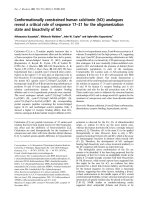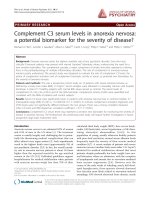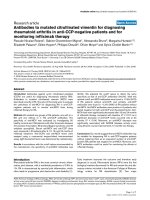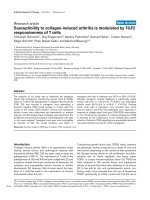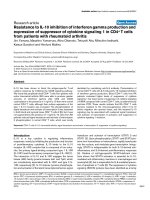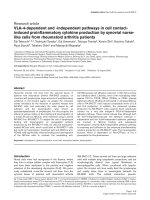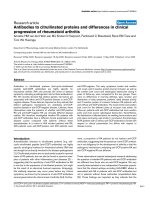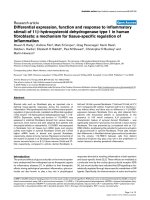Báo cáo y học: "Pathways to child and adolescent psychiatric clinics: a multilevel study of the significance of ethnicity and neighbourhood social characteristics on source of referral" pptx
Bạn đang xem bản rút gọn của tài liệu. Xem và tải ngay bản đầy đủ của tài liệu tại đây (293.24 KB, 12 trang )
RESEARCH Open Access
Pathways to child and adolescent psychiatric
clinics: a multilevel study of the significance of
ethnicity and neighbourhood social
characteristics on source of referral
Anna-Karin Ivert
1*
, Robert Svensson
1
, Hans Adler
3
, Sten Levander
1
, Per-Anders Rydelius
2
, Marie Torstensson Levander
1
Abstract
Background: In the Swedish society, as in many other societies, many children and adolescents with mental
health problems do not receive the help they need. As the Swedish society becomes increasingly multicultural,
and as ethnic and economic residential segregation become more pronounced, this study utilises ethnicity and
neighbourhood context to examine referral pathways to child and adolescent psychiatric (CAP) clinics.
Methods: The analysis examines four different sources of referrals: family referrals, social/legal agency referrals,
school referrals and health/mental health refer rals. The referrals of 2054 children aged 11-19 from the Stockholm
Child-Psychiatric Database were studied using multilevel logistic regression analyses.
Results: Results indicate that ethnicity played an important role in how children and adolescents were referred to
CAP-clinics. Family referrals were more common among children and adolescents with a Swedish background than
among those with an immigrant background. Referrals by social/legal agencies were more common among children
and adolescents with African and Asian backgrounds. Children with Asian or South American backgrounds were more
likely to have been referred by schools or by the health/mental health care sector. A significant neighbourhood effect
was found in relation to family referrals. Children and adolescents from neighbourhoods with low levels of
socioeconomic deprivation were more likely to be referred to CAP-clinics by their families in comparison to children
from other neighbourhoods. Such differences were not found in relation in relation to the other sources of referral.
Conclusions: This article reports findings that can be an important first step toward increasing knowledge on
reasons behind differential referral rates and uptake of psychiatric care in an ethnically diverse Swedish sample.
These findings have implications for the design and evaluation of community mental health outreach programs
and should be con sidered when developing measures and strategies intended to reach and help children with
mental health problems. This might involve providing information about the availability and accessibility of health
care for children and adolescents with mental health problems to families in certain neighbourhoods and with
different ethnic backgrounds.
Background
Since the late 1920s and using the Health Registers in
Sweden, cohorts of child and adolescent psychiatric
(CAP) patients have been described and followed over
different periods of time up to 30 years[1-4] . These stu-
dies have given information regarding the characteristics
of the children, adolescen ts and their famili es seeking
help from child and adol escent psychiatric services. The
results have raised questi ons about different possibilities
for anticipating who these children are prior to becom-
ing patients in order to discuss preventive measures.
Recent results [4] indicate paths into later CAP-care and
care in General Psychiatry which can be identified
among patients in paediatric health care.
* Correspondence:
1
Faculty of Health and Society, Malmö University, SE-205 06 Malmö, Sweden
Full list of author information is available at the end of the article
Ivert et al. Child and Adolescent Psychiatry and Mental Health 2011, 5:6
/>© 2011 Ivert et al; licensee BioMed Central Ltd. This is an Open Acce ss article distributed under the terms of the Creative Commons
Attribution License ( which permits unres tricted use, distri bution, and re production in
any medium , provided the original work is properly cited.
As the Swedish society, like that of most other
Western European countries, becomes increasingly mul-
ticultural, and as residential segregation, economic as
well as ethnic, becomes more pronounced, the challenge
of meeting children’s and adolescents’ mental health
needs requires us to focus more attention on the issues
of ethnicity and residential neighbourhood. The Swedish
population has changed over the last decades from a
relatively homo genous group to a population where
almost 20 percent of all children and adolescents under
age 18 are either born abroad or born in Sweden with
two parents born outside Sweden. The Swedish immi-
grant population is primarily comprise d of three groups;
labour immigrants who arrived from the other Nordic
countries and southern Europe during the 1950s and
1960s; politica l refugees from Latin America (mainly
from Chile) and Iran who arrived during the 1980s; and
refugees who arrived during the final deca de of the 20
th
andthefirstyearsofthe21
st
century from the former
Yugoslavia, the former Soviet union, Iraq and Somalia
[5]. According to data from the Swedish National Board
of Health and Welfare, immigrants from non-European
countrie s had worse health [5], were more likely to have
low socioeconomic status, and more often lived in dis-
advantaged neighbourhoods [6].
A number of European and North American studies
have found differences in children’ s m ental health and
mental healthcare utilization to be associated with both
ethnicity and chara cteristics of the neighbourhood of
residence [7-11]. Less is known about how ethnicity and
neighbourhood characteristics affect the way children
and adolescents come into contact with mental health-
care services.
Many children and adolescents with mental health
problems do not receive the help they need [12,13]. An
important first step towards p roviding appropriate pre-
vention and care is extended knowledge on how chil-
dren and adolescents with mental health problems are
referred to psychiatric care. Parents perceiving that their
child has mental health problems is oft en a prerequisite
for a referral to mental health care, and parental aware-
ness of the existence of a problem has been identified as
the key initial step in help-seeking [14]. However, refer-
rals to mental health care may also be made by other
adults, such as representatives of social agencies or
school personnel. According to Verhulst [15], the recog-
nition of children’ s behaviour as being problematic by
parents or other adults is dependent on the latter’ s
“awareness of the problem, their distress threshold, their
educational level, beliefs, and attitudes, as well as other
cultural and environmental factors” [15]. Togeth er these
factors will affec t which children will be referred to psy-
chiatric care and by whom. The present study, using
Swedish health and population registers, focuses on
those children and adolescents who have already entered
the psychiatric care system and provides insights into
the characteristics of children and adolescents who are
in treatment by assessing the question of whether chil-
dren’sandadolescents’ referral pathways to child and
adolescent psychiatric clinics in a Swedish sample vary
by ethnicity and neighbourhood of residence.
The role of ethnicity in children’s referrals to mental
healthcare
Previous research indicates that ethnicity may be asso-
ciated with how individuals come into contact with
mental healthcare services [16-20]. For example, African
American children tend to be referred to mental health-
care services by social agencies, child welfare and the
juvenile justice system more often than children of Cau-
casian origin [17], while children of Latino origin are
more often referred by the school system [21] or their
families [17]. Furthermore, a study from the United
Kingdom showed that family referrals were rare among
Bangladeshi children compared to children with other
ethnic backgroun ds [22], and results from an Irish study
indicates that immigrant children more often were
referred through schools than were children with Irish
background [23].
There is no simple explan ation for the observed differ-
ences in sources of referrals among children from differ-
ent ethnic groups. One explanation that is often
presented argues that referral patterns are influenced by
socio-cultural factors [16,18,24-26]. Children who are
rece nt immigrants may experience problems in adjusting
to their new environment, a nd school staff, for example,
may judge their behaviour as deviant and consequently
refer them to the mental healthcare [21]. Socio-cultural
differences may also manifest themselves in ethnic differ-
ences in families ’ perceptions of whether or not a pro-
blem should be defined as mental health-related, and of
whether the problem warrants a mental health care refer-
ral [16,25-28]. Previous research has found ethnic differ-
ences in parental recognition of me ntal health problems
in their children [28,29], indicating differences in toler-
ance thresholds for mental health problems. Even if the
threshold for what is considered a mental health problem
wouldbethesameacrossethnicgroupstheremaybea
reporting bias. A vignette study by Chavez et al [30] indi-
cated that Latino children were judged as less in need of
service than children w ith Anglo names, by parents as
well as mental health care providers (se also [31]). The
decision to seek help for a mental health problem may be
associated with stigmatization [17,18,32,33]. In some eth-
nic groups, the stigma of having mental illness in the
family may prevent parents from referring their children
to mental health care. There are also researchers who
argue that children from some ethnic groups are more
Ivert et al. Child and Adolescent Psychiatry and Mental Health 2011, 5:6
/>Page 2 of 12
likely to be labelled by social agencies as being in need of
mental health care than others [21], and that ethnic dif-
ferences in referral pathways emerge as a consequence of
this. There are also results indicating the presence of eth-
nicdifferencesinthetypeofproblemsthatarerecog-
nised and referred, with internalising problems being
more likely to remain unreferred among minority adoles-
cents than among Caucasian adolescents, whereas
African American adolescents were more likely to be
referred for externalising behaviour [34].
A majority of the previous research on ethnic differ-
ences in children’s referral pathways has been conducted
in the USA, and the results may not be directly applic-
able to a Swedish and/or Western European context.
The social structure and the ethnic composition of
Sweden, with her relatively new immigrant population,
differ significantly from those of the USA. Nevertheless
similar patterns of discrimination and of inequalities in
access to health care may be present in the Swedish
context and affect referral patterns to Child and adoles-
cent psychiatric care.
The role of neighbourhood characteristics in children’s
referrals to mental health care
There is a growing body of research examining the asso-
ciation between neighbourhood characteristics and men-
tal health problems among ch ildren [7,8,10,11,35,36].
Factors such as neighbourhood socioeconomic depriva-
tion and, social capital (often measured as social cohe-
sion and informal social control) have been identified as
having significant effects on children’ s mental health
over and above individual level variables [7,36-38].
Socioeconomic deprivation and social capital have been
hypothesised to affect mental health in children (and
adults)throughfactorssuchasaccesstofamilyadvice
and support, informal socia l networks with neighbours
that might contribute to support, child rearing methods,
perceptions of risk and danger, and access to resources
in the community (see for example [9,11,35,39]. These
same facto rs may also affe ct the ways in which children
and adolescents are referred to psychiatric care. Previous
studies have found that individuals in poor communities
have less access to speciality care [40], and neighbour-
hood poverty has been identif ied as key to u nderstand
ethnic disparities in mental health care utilisation [41].
In a recent study Carson, Cook and Alegria [42] found
that Haitian youth living in high-poverty areas were less
likely to receive adequate mental health care compared
to Haitian youths living in low-poverty areas.
The availability of health care options in the neigh-
bourhood, a nd of knowledg e on how to access them,
may influence how individuals experience and come in
contact with mental health care services [18]. Social
norms relating to which behaviours are viewed as
undesirable and deviant may al so influence referral pat-
terns to mental health care, i.e. the behaviours that are
viewed as acceptable and normal may vary by neigh-
bourhood context [16], just as child rearing methods
and support from informal social n etworks. The avai l-
ability of and knowledge about heal th care options may,
likethepropensitytoseekhelp,becorrelatedwith
neighbourhood levels of socioeconomic deprivation and
social capital. A theoretical model developed by
Wikström [43] to explain another kind o f problem, i.e.
crime, suggests that community structure (resources and
rules) influences both the personalities and lifestyles of
the individuals who live there, and also their routine
behaviours. This implies that the characteristics of the
neighbourhood of residence may influence how people
define health and ill-health, and may consequently affect
the type of problems for which they choose to contact
mental health services, for example.
A family referral may be interpreted as indicating the
parents’ recogn ition and acceptance of the child ’spro-
blem and of the fact that the problem warrants mental
health care, and also that the parents believe that mental
health care services can be helpful in solving the pro-
blem. Referrals by an external agency, on the other
hand , may be associated with a higher level of coercion,
and even if where the approval of the parents is
required, the parents’ support for and confidence in the
care provided may not be as strong as if the parents had
themselves initiated the referral. Parental recognition of
their child’ s ment al health problems may also imply
early detection and treatment of the problem. A better
understanding of the ways in which ethnicity and r esi-
dential neighbourhood influence children’s referral pat-
terns to mental health care services may provide
important insights into how best to design and develop
health promotion strategies to reach children with men-
tal health problems. The key issue for this paper was to
study the referral sources by which children and adoles-
cents are referred to CAP-clinics (i.e. who initiates the
contact with mental health care services), and whether
referral pathways differ by ethnicity and neighbourhood
of residence. In the analysis we examine four different
referral sources: family referrals, social/legal agency
referrals, school referrals and health/mental health refer-
rals. We hypothesise that children will be referred by
different sources depending on (1) ethnic background
and (2) the neighbourhood of residence and its level of
neighbourhood socioeconomic deprivation.
Methods
Study population and data
The S tockholm Child-Psychiatric Database comprises
approximately 7600 children who have been in contact
with child and adolescent psychiatric clinics (CAP-clinics)
Ivert et al. Child and Adolescent Psychiatry and Mental Health 2011, 5:6
/>Page 3 of 12
in the county of Stockholm. The CAP-system comprises
the county of Stockholm’s outpatient child psychiatric gui-
dance clinics for children and adolescents up to the age of
20. These clinics maintain a computerised system for
patient statistics based on structured information that is
gathered in relation to each child who attends a CAP-
clinic. The clinician (child psychiatrist, psychologist or
social worker) is required to fill out a form with informa-
tion on variables such as cause of referral, diagnoses
(according to the DSM-IV, diagnoses are primarily filled
out for those children who at some time have subjects for
inpatient care), psychosocial stressors, length and type o f
treatment, referral source, residential neighbourhood, and
social background. The Stockholm Child-Psychiatric Data-
base includes children born in 1989 o r earlier who had
contacts with CAP-clinics that were concluded between
2003 and 2005.
Thepresentstudyincludesonlythosechildrenwho
had their first contact with the CAP-clinics in the year
2000 or later, and who were living in the municipality of
Stockholm at the time their contacts with the CAP-
clinics were concluded.
The Stockholm municipality is divided into 132 neigh-
bourhoods. In this study, a neighbourhood is synon-
ymous with a census tract. The child/adolescent’ s
residential neighbourhood is measured at the time of
their final appointment. The present study only includes
neighbourhoods from which there are at least 10 chil-
dren in the Stockholm Child-Psychiatric Database (see
appendix for a discussion on number of children per
neighbourhood). This yields a final sample of 2054 chil-
dren and adolescents (representing about 94 percent of
the children who attended child and adolescent psychia-
tric clinics in the Stockholm municipality) from 82
neighbourhoods (with a range of 10-74 children per
neighbourhood).
Measures
Referral source
The dependent variable analysed in this study is the
referral source that initiated the child’s or adolescen t’s
contact with the CAP-clinic. Referral sources were
grouped into four categories; family referrals (i.e. family
members and self-referrals; n = 1662; 80.9%), social/
legal agency referrals (i.e. social services, lawyers; n =
162; 7.9%), school referrals (i.e. teachers, school health
care staff, after school centres; n = 414; 20.2%), and
health/mental health referrals (i.e. general practitioner,
child health centre, adult psychiatric services; n = 722;
35.2%).The variables are dichotomized as 1 = the child
or adolescent has been referred to a CAP-clinic by the
source at least once, and 0 = the child has never been
referred to a CAP-clinic by the source. As a result of
data constraints it is not possible to say anything about
which source referred the child/adolescent in connec-
tion with their first contact with the child and adoles-
cent psychiatric clinics, but rather only whether or not
the child/adolescent has been referred by a particular
source at any time.
Ethnicity was measured on the basis of the parents’
country of birth; children whose parents were both born
abroad are considered as having an immigrant back-
ground. The children were classified into one of six eth-
nic groups: Swedish, Nordic (other than Sweden),
European, Asian, South American, and African. All
these subgroups obviously cont ain important within-
group heterogeneity. However it is not possible to create
smaller, more homogenous groups since for some chil-
dren and adolescents, the available data refer only to the
region of origin (e.g. other Asian). In the analysis, the
ethnicity measure is employed in the form of five
dummy variables for Nordic, European, Asian, South
American and African background, with Swedish back-
ground being used as the reference category. Initial ana-
lysis did not show any significant differences in referral
source between first and second generation immigrants
and therefore we did not distinguish between first and
second generation immigrants in the analysis.
Three demographic variables that may be associated
with referral patterns to CAP-clinics were included in
the analysis as contro l variables; gender, age, and family
structure. Age at first contact was included in the analy-
sisasacontinuousvariable.Family structure was
divided into two categories based on whether or not the
child was living with both parents.
Neighbourhood socioeconomic deprivation
The neighbourhood level variable used in this study is
neighbourhood socioeconomic deprivation, and can be
described as representing socioeconomic status at the
neighbourhood level. In previous studies, socioeconomi c
deprivation has been found to be associated with differ-
ences in children’s mental health [7,34] and we wanted to
examine if deprivation was also associated with children’s
referrals to mental health care services. Data on Neigh-
bourhood deprivation are derived from the City of Stock-
holm statistics department (USK), and refer to the year
2004. At the neighbourhood level, four variables are used
to measur e the lev el of socioeconomic deprivation in
each area: the proportion unemployed, the proportion
with less than 12 years of education, the proportion of
low income earners (persons with an income below
120,000 SEK/year), and the proportion of high income
earners (persons with an income above 360,000 SEK/
year). In order to summarise these data to a single con-
struct, a factor analysis was carried out. All four variables
loaded highly on a single factor using non-rotated Princi-
pal Axis Factoring ( loadings >.76), which explained 78
percent of the total variance. Regression factor scores
Ivert et al. Child and Adolescent Psychiatry and Mental Health 2011, 5:6
/>Page 4 of 12
were calculated for th e socioeconomic deprivation con-
struct, yielding a continuous, normal distributed variable,
with a mean value of 0. The socioeconomic deprivation
variable is included in the analysisasacontinuousvari-
able; a high value indicates a high level of neighbourhood
socioeconomic deprivation.
Analytical approach
In order to test our hypothesis, a number of multilevel
(hierarchical) logistic regressions were carried out using
HLM 6.6 [44]. The multilevel approach allows us to
examine neighbourhood effec ts and individual level
effects in the same model, and enables us to determine
whether neighbourhood socioeconomic deprivation
affects children’s and adolescent’s pathways to care over
and above the effects of individual characteristics.
The Intra Class Correlation (ICC) has been calculated
in order to estimate the between-neighbourhood var-
iance. According to Snijders & Bosker [45] the ICC in
multilevel logistic regression is calculated as: Neighbour-
hood variance/(neighbourhood variance + π
2
/3). The
largertheICCisthemoreofthevarianceintheout-
come variable, i.e. source of referral, can be attributed
to characteristics in the neighbourhood where the child/
adolescent lives. T he odds ratios (ORs) in multilevel
logistic regression models are interpreted in the s ame
way as the estimates in a single-level logistic regression.
We estimated four models for each source of referral,
with children/adolescents at the first level, and neigh-
bourhoo ds at the second level. Model I represents w hat
is referred to as an empty model, which is an intercept
only model with no independent variables. The empty
model indicates whether the re are any significant differ-
ences between neighbourhoods, and a lso shows the way
the variance is distributed between individuals and
neighbourhoods. In Model II, ethnicity was added in
order to test its correlation with the dependent variable,
and to establish whether the neighbourhood variation
remains significant after controlling for compositional
effects associated with ethnicity. Model III included the
control variables gender, age and family structure in
order to examine their effect on the correlation between
ethnicity and source of referral and on the be tween-
neighbourhood variance. In the final model (model IV),
neighbourhood socioeconomic deprivation was intro-
duced in order to test whether the level of neighbour-
hood socioeconomic deprivation had an independent
effect on the source of referral.
Ethics
The study was approved by the Ethics Committee at
Karolinska Institutet, Stockholm (Regionala e tikpröv-
ningsnämnden, Stockholm).
Results
Table 1 provides information on the distribution of indi-
vidual- and neighbourhood-level variables by ethnicity.
Approximately 18 per cent of the children in the final
sample have an immigrant background. Almost 70 per-
cent o f the children with an immigrant background
came from countries outside Europe (Asia 40%, South
America 17% and Africa 11%). A majority of the
Table 1 Characteristics of the 2054 children in the sample (percentages/mean)
Variable Sweden
(n = 1678, 82%)
Nordic countries
(other than Sweden)
(n = 54, 3%)
Other European
countries
(n = 73, 4%)
Asia
(n = 145, 7%)
South America
(n = 64, 3%)
Africa
(n = 40, 2%)
Gender (%)
Boys 34 24 43 41 47 48
Girls 66 76 57 59 53 52
Age (mean) 15 15 15 16 15 16
Family structure (%)
Living with both parents 45 35 48 45 34 28
Not living with both
parents
55 65 52 55 66 72
Neighbourhood
socioeconomic deprivation¹
(%)
Low 35.7 20.4 19.2 8.3 15.6 10.0
Middle 36.9 33.3 30.1 22.8 20.3 22.5
High 27.4 46.3 50.7 69.0 64.1 67.5
¹For descriptive statistics, level of socioeconomic deprivati on was divided into three groups (based on tertile cut-off points) ranging from low levels to high levels
of socioeconomic deprivation.
Ivert et al. Child and Adolescent Psychiatry and Mental Health 2011, 5:6
/>Page 5 of 12
children and adolescents in the sample are girls, and did
not live with both of their parents. The average age at
first contact is 15 years (range 11 to 19) for both immi-
grant children and chi ldren with a Swedish background,
with the exception of the Asian and African groups
where the average age at first contact is 16 years. Living
in a neighbourhood with high levels of socioeconomic
deprivation was more co mmon among children with
immigrant background, especially among children from
the Asian and African group.
The most common source of referral was fa mily/self
referrals. However a chi-square test of diffe rences in
referral sources in dicated that children with Swedish,
Nordic or South American backgrounds were more
often referred to child and adolescent psychiatric clinics
by a family member than were children with a back-
ground in European countries (except the Nordic coun-
tries), Asia or Africa (x
2
= 38.97, p < .001). In the
African group, just over 50 percent had been referred by
a family member, as compared to almost 80 percent in
the total sample. Overall, children with an immigrant
bac kground were more often referred to CAP-clinics by
social services/legal agencies, the school system or
health/mental health care services than were children
with a Swedish background (x
2
= 26.49, p < .001; x
2
=
16.35, p < .01; x
2
= 17.06, p < .01).
Tables 2, 3, 4 and 5 present odds ratios for each refer-
ralsourcerespectivelyfollowingastepwiseinclusionof
individual and neighbourhood variables.
Fixed effects
Table 2 shows that the oddsforeverhavingbeen
referred to a CAP-clinic by the family were signifi-
cantly lower for those children with a background in
African countries (OR = 0.28) or in Europe outside the
Nordic countries (OR = 0.50). This association remains
after controlling for individual- and neighbourhood
level variables. In the final model, the odds for ever
having been referred to a CAP-clinic by the family
were also significantly l ower for those children who
were older at the time of their first contact with a
CAP-clinic (OR = 0.78), and for those children who
lived in a neighbourhood with a low level of socioeco-
nomic deprivation (OR = 0.68).
Table 2 Odds ratios for family referrals, with 95% confidence interval (CI). N = 2054
Model I
Empty model
Model II Model III Model IV
Fixed effects
Individual-level variables
Ethnicity
Swedish 1 (reference) 1 (reference) 1 (reference)
Nordic countries (other than Sweden) 1.15 (0.56-2.39) 1.05 (0.48 2.26) 1.23 (0.58-2.57)
Other European countries 0.50 (0.30-0.84)* 0.45 (0.26-0.78)** 0.53 (0.31-0.92)*
Asia 0.67 (0.44-1.02) 0.69 (0.47-1.03) 0.88 (0.59-1.33)
South America 1.06 (0.53-2.11) 0.94 (0.47-1.87) 1.17 (0.59-2.34)
Africa 0.28 (0.14-0.60)** 0.30 (0.14-0.65)** 0.35 (0.17-0.72)**
Gender
Girl 1 (reference) 1 (reference)
Boy 0.91 (0.73-1.14) 0.95 (0.76-1.20)
Age 0.78*** 0.78***
Family structure
Living with both parents 1 (reference) 1 (reference)
Not living with both parents 0.86 (0.67-1.11) 0.91 (0.71-1.17)
Neighbourhood-level variable
Neighbourhood socioeconomic deprivation 0.68 (0.62-0.76)***
Random effects
Between-neighbourhood variance (SE)
1
0.266 (0.515) *** 0.205 (0.452) *** 0.173 (0.416)*** 0.007 (0.084)
ICC (%) 7.5 5.9 5.0 0.2
Explained variance (%) - 21.3 33.3 97.3
***p < .001, **p < .01, *p < .05.
1
Standard error.
Ivert et al. Child and Adolescent Psychiatry and Mental Health 2011, 5:6
/>Page 6 of 12
Odds ratios for referrals to child and adolescent psy-
chiatric clinics by social/legal agencies (table 3) were sig-
nificantly higher for children with a background in
Europe outside the Nordic countries (OR = 2.21) or in
Asian (OR = 2.03) and African (OR = 4.51) countries;
this associa tion remains after a djusting for sex, a ge,
family structure. When neighbourhood socioeconomic
deprivation is entered in model IV just African back-
ground remain significantly associated with social/legal
agency referrals (OR = 3.55). In the final model, referrals
by social/legal agencies were also significantly associated
with age at first contact (OR = 0.77), not living with
both parents (OR = 2.92), and living in a neighbourhood
with a high level of socio economic deprivation (OR =
1.29).
Tables 4 and 5 show that Children from an Asian or
South American background were more often referred
to CAP-clinics by schools (OR = 1.57/2.08) and other
health/mental health care institutions (OR = 1.57/2.11).
This association remains after adjusting for individual-
and neighbourhood level variables. In the final models,
the odds for being referred to CAP-clinics by schools or
other health/mental health care institutions were higher
for boys (OR = 1.45/1.24), and for those who did not
live with both of their parents (OR = 0.74/0.70). Refer-
rals by schools and other health/mental health care
institutions were also significantly associated with age at
first contact (OR = 0.84/0.90). There were no significant
association between referrals by s chools or health/men-
tal health care institutions and level of neighbourhood
socioeconomic deprivation.
Random effects
The only significant neighbourhood effect was found in
relation to family referrals (Table 2). The results from
the empty model indicate that about 7.5 percent of the
varian ce in family referrals to child and adolescent psy-
chiatric clinics may be explained b y the neighbourhood
of residence. This neighbourhood effect decreases by
approximately 21 percent when ethni city is adjusted for,
indicating that part of the between-neighbourhood var-
iance is due to compositional effects, i.e. people with
certain characteristics (e.g.ethnicity)thataffectthe
probability of the family being the source of referral
tend to cluster in the same neighbourhoods. Adjustment
for the other individual-level variables reduces the
Table 3 Odds ratios for social/legal agency referrals, with 95% confidence interval (CI). N = 2054
Model I
Empty model
Model II Model III Model IV
Fixed effects
Individual-level variables
Ethnicity
Swedish 1 (reference) 1 (reference) 1 (reference)
Nordic countries (other than Sweden) 1.41 (0.65-3.06) 1.16 (0.51-2.63) 1.04 (0.46-2.36)
Other European countries 2.19 (1.13-4.24)* 2.21 (1.10-4.44)* 1.84 (0.86-3.94)
Asia 1.82 (1.09-3.05)* 2.03 (1.22-3.38)** 1.50 (0.85-2.67)
South America 1.70 (0.77-3.75) 1.32 (0.58-2.97) 1.06 (0.45-2.50)
Africa 4.57 (2.43-8.60)*** 4.51 (2.30-8.85)*** 3.55 (1.77-7.10)**
Gender
Girl 1 (reference) 1 (reference)
Boy 1.09 (0.76-1.57) 1.08 (0.76-1.54)
Age 0.78 (0.71-0.85)*** 0.77 (0.71-0.85)***
Family structure
Living with both parents 1 (reference) 1 (reference)
Not living with both parents 3.11 (2.12-4.56)*** 2.92 (1.98-4.29)***
Neighbourhood-level variable
Neighbourhood socioeconomic deprivation 1.29 (1.10-1.52)**
Random effects
Between neighbourhood variance (SE)
1
0.088 (0.296) 0.024 (0.154) 0.007 (0.090) 0.008 (0.091)
ICC (%) 2.6 0.7 0.2 0.2
Explained variance (%) - 73.1 92.3 92.3
***p < .001, **p < .01, *p <.05.
1
Standard error.
Ivert et al. Child and Adolescent Psychiatry and Mental Health 2011, 5:6
/>Page 7 of 12
neighbourhood effect further. When neighbourhood
socioeconomic deprivation is introduced in the final
model (model IV), th e between-neighbourhood variance
in family referrals to CAP-clinics is reduced to insignifi-
cance. Individua l- and neighbourhood-level variables
together explain approximately 97 percent of the initial
variation in family referrals between neighbourhoods.
No significant neighbourhood effects on referrals are
found in relation to referrals by the social services/legal
agencies, the school system, or health/mental health
care services (Tables 3, 4 and 5).
Discussion
This study has addressed the question of how children
and adolescents are referred to CAP-clinics, and
whether referral patterns vary by ethnicity and neigh-
bourhood of residence. This is an area of research
where the knowledge is limited, especially outside the
US context, and this study provides important knowl-
edge on factors that influence children’s and adolescents’
pathways into care, factors which can also be used for
developing preventive measures. In line with our first
hypothesis, and also with previous research as described
in the introduction, the results indicate that ethnicit y
plays an important role in how children and adolescents
are referred to child and adolescent psychiatric clinics.
Family referrals were found to be more common among
children and adolescents with a Swedish background
than they were among those with an immigrant back-
ground. Referral s by social/legal agencies were more
common among children and adolescents with African
and Asian backgrounds and among children and adoles-
cents from Europe outside the Nordic countries. Chil-
dren with an Asian or South American background
were more likely than children and adolescents with
other backgrounds to have been referred by schools or
by health/mental health care services.
The data available in this study cannot explain the
observed differences in the source of referral between
ethnic groups. In a review by Morgan et al. [18], how-
ever, three areas are identified as being important to an
understanding of differences in referrals to mental
health care between individuals from different ethnic
backgrounds; (1) social networks, (2) cultural contexts
Table 4 Odds ratios for school referrals, with 95% confidence interval (CI). N = 2054
Model I
Empty model
Model II Model III Model IV
Fixed effects
Individual-level variables
Ethnicity
Swedish 1 (reference) 1 (reference) 1 (reference)
Nordic countries (other than Sweden) 1.51 (0.88-2.58) 1.54 (0.87-2.72) 1.46 (0.80-2.64)
Other European countries 1.12 (0.64-1.93) 1.06 (0.62-1.80) 0.99 (0.61-1.60)
Asia 1.57 (1.11-2.22)* 1.66 (1.17-2.34)** 1.48 (1.07-2.05)*
South America 2.08 (1.32-3.28)** 1.94 (1.23-3.07)** 1.79 (1.13-2.85)*
Africa 1.85 (0.88-3.90) 2.00 (0.97-4.15) 1.81 (0.84-3.90)
Gender
Girl 1 (reference) 1 (reference)
Boy 1.45 (1.15-1.83)** 1.45 (1.15-1.82)**
Age 0.84 (0.79-0.90)*** 0.84 (0.79-0.90)***
Family structure
Living with both parents 1 (reference) 1 (reference)
Not living with both parents 0.76 (0.63-0.93)** 0.74 (0.61-0.90)**
Neighbourhood-level variable
Neighbourhood socioeconomic deprivation 1.11 (0.99-1.24)
Random effects
Between-neighbourhood variance (SE)
1
0.052 (0.228) 0.022 (0.149) 0.015 (0.124) 0.006 (0.080)
ICC (%) 1.6 0.7 0.5 0.2
Explained variance (%) - 56.3 68.8 87.5
***p <.001, **p <.01, *p <.05.
1
Standard error.
Ivert et al. Child and Adolescent Psychiatry and Mental Health 2011, 5:6
/>Page 8 of 12
and belie fs about mental illne ss, and (3) the range of
available care options. Social networks may be impor-
tant to an understanding of ethnic disparit ies in referral
patterns in different ways. Some parents might choose
to turn to their social network for help instead of turn-
ing to the public health care system. The social network
could also be an important source of variation in atti-
tudes towards professional help seeking, and in k nowl-
edge about available health care options. A study by
Lindsey et al [20] found that having a large social net-
work was associated with the utilisatio n of school men-
tal health services among African American adolescents.
Cultural contexts and beliefs ab out mental illness may
be associated with pare ntal differences in tolerance
thresholds and their perceptions of whether or not a
problem behaviour is defined as being mental health-
related, and parents’ attitudes to psychiatric care
[16,25,26,28]. An additional explanation may be that the
level o f stigmatization associated w ith mental health
problems differs between ethnic groups [17,18,32]. It is
also possible that parents of Swedish origin have better
knowledge of, and access to, available health care
options, and that contacting child and adolescent psy-
chiatric clinics is a natural way for them to deal with
their children’ s problems. However, results from a
British study showed no significant differences in level
of awareness mental health care services between
Pakistani and white British mothers, though Pakistani
mothers were less likely to consider referral for pro-
blems judged as mild or moderate [27].
Theresultsfromthepresentstudyindicatethat
agency referrals were more common among children
and adolescents with an immigrant background (with
the exception o f children and a dolescents from the
Nordic countries). This may be associated with the
behaviour of children who do not belong to the majority
population being more likely to be labelled as deviant by
social agencies, for example, or school staff. But this
over-reporting of children with an immigrant back-
ground may also be a consequence of these children
being less likely to be referred to child and adolescent
psychiatric clinics by their families, and of their problem
behaviour, as a result, having being identified and
reported by an external party. Previous studies have
Table 5 Odds ratios for health/mental healthcare referrals, with 95% confidence interval (CI). N = 2054
Model I
Empty model
Model II Model III Model IV
Fixed effects
Individual-level variables
Ethnicity
Swedish 1 (reference) 1 (reference) 1 (reference)
Nordic countries (other than Sweden) 1.37 (0.75-2.50) 1.41 (0.76-2.62) 1.39 (0.74-2.61)
Other European countries 1.39 (0.86-2.25) 1.34 (0.82-2.20) 1.32 (0.83-2.11)
Asia 1.57 (1.16-2.13)** 1.62 (1.18-2.22)** 1.58 (1.19-2.11)**
South America 2.11 (1.24-3-57)** 2.07 (1.22-3.51)** 2.03 (1.21-3.38)**
Africa 1.07 (0.49-2.34) 1.16 (0.55-2.45) 1.13 (0.52-2.46)
Gender
Girl 1 (reference) 1 (reference)
Boy 1.24 (1.02-1.50)* 1.24 (1.02-1.50)*
Age 0.90 (0.85-0.95)*** 0.90 (0.85-0.95)***
Family structure
Living with both parents 1 (reference) 1 (reference)
Not living with both parents 0.70 (0.60-0.83)*** 0.70 (0.60-0.83)***
Neighbourhood-level variable
Neighbourhood socioeconomic deprivation 1.02 (0.92-1.13)
Random effects
Between-neighbourhood variance (SE)
1
0.027 (0.164) 0.011 (0.105) 0.005 (0.074) 0.006 (0.078)
ICC (%) 0.8 0.3 0.2 0.2
Explained variance (%) - 62.5 75.0 75.0
***p <.001, **p <.01, *p <.05.
1
Standard error.
Ivert et al. Child and Adolescent Psychiatry and Mental Health 2011, 5:6
/>Page 9 of 12
identified school personnel as important actors for both
the detection of mental health problems and for making
referral s to mental health care [33,46,47]. As has already
been noted, Engqvist & Rydelius [4] have found that
information from the paediatric care sector plays an
important role in identifying and supporting children
with mental health problems, since extensive and recur-
rent hospital care during childhood is associated with an
increased likelihood of subsequent psychiatric illness.
The hypothesised relationship between neighbourhood
of reside nce and differences in referral sources wa s
found in this study to be ambiguous. On the one hand
we found a significant neighbourhood effect on family
referrals, i.e. it was more likely for children and adoles-
centstobereferredtochildand adolescent psy chiatric
clinics by the family in some neighbourhoods than it
was in others. On the other hand no significant neigh-
bourhood effect was found in relation to social/legal
agency referrals, school referrals, or health/mental health
service referrals.
The finding showing that there is a neighbourhood
effect on family referrals is in line with the theoretical
discussion presented in the introduction, i.e. that char-
acteristics of the social settings in which children and
adolescents live will have an independent eff ect on the
sources by which they are r efer red by to child a nd ado-
lescent psychiatric clinics. Given the rather s trong asso-
ciation found between ethnicity and family referrals, it
might be assumed that the neighbourhood effect was
largely due to compositional factors, but controlling for
ethnicity only reduced the neighbourhood effect by
approximately 20 percent. The structure of the commu-
nity may influence the routine behaviour of the people
who live there. Families living in a neighbourhood
where referrals to child and adolescent psychiatric
clinics are part of the routine will perceive this as a way
of dealing with their children’ s problems to a greater
extent. Some of the mechanisms disc ussed in connec-
tion with ethnic differences in referral patterns may also
serve as explanations for the observed differences
between neighbourhoods. Knowledge about and access
to different health care options may differ between
neighbourhoods in the same way a s the type of beha-
viours that are regarded as mental health-related and
opinions on how to deal with problems of this kind. In
the introduction we hypothesised that the neighbour-
hood level of socioeconomi c deprivation would be asso-
ciated with differences in referrals, and controlling for
socioeconomic deprivation would reduce the be tween-
neighbourhood variance in family referrals to non-signif-
icance. A high level of socioeconomic deprivation was
found to be negatively associated with family referrals,
indicating that children living in neighbourhoods char-
acterised by high levels of socioeconomic deprivation
are less likely to be referred to the child and adolescent
psychiatric clinics by their families. However, further
resear ch is needed to identify the mechanism explaining
how socioeconomic deprivation affect families help seek-
ing behaviour.
The absence of neighbourhood effects on the other
referral sources indicates that i t is individual charact eris-
tics in the child or adolescent rather than where the child/
adolescent live that influences referrals by social/legal
agencies, schools, or health/mental health care services.
Limitations
A number of limitations associated with the study
should also be mentioned. First, there is no information
available on w ho first initiated the contact with child
and adolescent psychiatric clinics. This is an area that
requires further research, sinceitispossiblethatchil-
dren who are initially referred by their families are
younger and that their problems t herefore have been
recognised at an earlier stage. It i s also possible that
most re-referrals are family/self-referrals as a conse-
que nce of families having greater knowledge of the care
system after the initial contact with CAP-clinics.
Though, the analysis in this study regards comparisons
between those children who at any time have been
referred by a particular source and those who never
have been referred by that same source. Second, the
proportion of children with an immigrant background is
much smaller in this sample than in the population; 18
percent as compared with 28 percent of all the children
in the municipality of Stockholm. The underrepresenta-
tion of children and adolescents with an immigrant
background in the CAP-clinics might be explained in
terms of unmet needs, or it may be due to their having
fewer mental health related problems than children
from the majority population. This is an area that
requires further investigation. Family-focused qualitative
studies of attitudes towards and knowledge about men-
tal health care for children, and population-based stu-
dies of the occurrence of mental health problems are
both needed. Third, as a result of data constraints, there
is no available information on residential neighbourhood
at first appointment. However, figures from Statistics
Sweden [48] indicate t hat (families with) children aged
6-17donotmovefrequentlyandamajorityofthe
moves that d o occur are within the same neighbour-
hood. Fourth, since no information was available on
individual/family socioeconomic status, the observed
effect of neighbourhood socioe conomic deprivation may
just be a compositional effect reflecting individual level
socioeconomic status. Previous research has shown that
poverty is highly correlated with coercive referrals and it
has been found to explain a large part of the observed
differences between children from different ethnic
Ivert et al. Child and Adolescent Psychiatry and Mental Health 2011, 5:6
/>Page 10 of 12
backgrounds [21]. However, in Sweden there are no
major financial constraints associated with receiving
mental health care, and in a revie w of t he literature
Zwaanswijk et al. [47] found that in countries with a
health system comparable to that of Sweden there was
no association between socioeconomic status and help
seeking. Finally, neighbourhoods would ideally be opera-
tionalised as locally defined areas with natural bound-
aries [ 39]. Data of this kind were unfortunately not
available for the purposes of this study and neighbour-
hoods were therefore operationalised as census tracts.
Conclusions
This article points to the existence of important ethnic
and social differences in children’ s and adolescents’
pathways to mental health care. The findings have sig-
nificant implications for the design and e valuation of
community mental health outreach programs, and must
be taken into consideration in connection with the
development of measures and strategies intended to
reach and he lp children with mental health problems
and also to prevent later CAP-care. This might involve
providing information about the availability and accessi-
bility of health care for c hildren and adolescents with
mental health problems to families in certain areas and
to certain ethnic groups. In addition, professionals work-
ing with children and adolescents, such as child psychia-
trists, general practitioners, paediatrics, social services,
and school staff, need to be aware of the differences in
referral patterns between children from different neigh-
bourhoods and with different ethnic backgrounds.
Appendix
In order to not lose too many level two units, we choose
to use only 10 individuals per higher level unit in this
study. The disparity in the number of children per
neighbourhood is adequately dealt with by the multilevel
regression analys is [45]. The general recommendation is
to have at least 25 individuals per level two unit, how-
ever some studies have shown that if the number of
neighbourhoods is large enough, the impact of having
only a few individuals per unit is rather small [49].
Author details
1
Faculty of Health and Society, Malmö University, SE-205 06 Malmö, Sweden.
2
Department of Woman and Child Health, Karolinska Institutet, Astrid
Lindgren Children’s Hospital, Karolinska University Hospital, SE-171 76
Stockholm Sweden.
3
Department of Medical sciences, Malmö, Lund
University, SE-221 84 Lund, Sweden.
Authors’ contributions
A-KI designed the study, performed the statistical analysis and wrote the
manuscript with support from the other co-authors. RS helped with the
interpretation of the statistical analysis, revised the manuscript and
contributed with valuable comments on the content.
HA, SL, P-AR, and MTL were responsible for designing the database and
collecting the data. They have also revised the manuscript and contributed
with valuable comments on the content. MTL has also supervised the
writing process. All authors have read and approved the final manuscript.
Competing interests
The authors declare that they have no competing interests.
Received: 11 November 2010 Accepted: 7 March 2011
Published: 7 March 2011
References
1. Fried I: Mellansjo school-home. Psychopathic children admitted 1928-
1940, their social adaptation over 30 years: a longitudinal prospective
follow-up. Acta Paediatr (Suppl) 1995, 408:1-42.
2. Nylander I: A 20-year prospective follow-up study of 2 164 cases at the child
guidance clinics in Stockholm. Acta Paediatr Scand (Suppl) 1979, 276:1-45.
3. de Chateau P: 30 Years Later: Children Attending a Counseling Service
Up to 3 Years of Age. Prax Kinderpsychol Kinderpsychiatr 1998,
47(7):477-485.
4. Engqvist U: Suicides, Psychotic Disorders and Criminality Among Former
Child and Adolescent Psychiatric Patients Followed into Adulthood. PhD
thesis Karolinska Institutet, Department of Women and Child Health; 2009.
5. National Board of Health and Welfare: Public Health Report 2009 Stockholm;
2009, (in Swedish).
6. National Board of Health and Welfare: Social Raport 2010 Stockholm; 2010,
(in Swedish).
7. Kalff AC, Kroes M, Vles JSH, Hendriksen JGM, Feron FJM, Steyaert J, van
Zeben TMCB, Jolles J, van Os J: Neighbourhood level and individual level
SES effects on child problem behaviour: a multilevel analysis. J Epidemiol
Community Health 2001, 55(4) :246-250.
8. Fagg J, Curtis S, Stanfeld S, Congdon P: Psychological Distress among
Adolescents, and Its Relationship to Individual, Family and Area
Characteristics in East London. Soc Sci Med 2006, 63(3):636-648.
9. Wickrama KAS, Bryant CM: Community context of social resources and
adolescent mental health. Journal of Marriage and the Family 2003,
65(4):850-866.
10. Linden J, Drukker M, Gunther N, Feron F, Os J: Children’s mental health
service use, neighbourhood socioeconomic deprivation, and social
capital. Soc Psychiatry Psychiatr Epidemiol 2003, 38(9):507-514.
11. Leventhal T, Brooks-Gunn J: The neighborhoods they live in: The effects
of neighborhood residence on child and adolescent outcomes. Psychol
Bull 2000, 126(2):309-337.
12. Verhulst FC, DER E: Factors associated with child mental health service
use in the community. Journal of Amer Academy of Child & Adolescent
Psychiatry 1997, 36(7):901.
13. Sourander A, Helstelä L, Ristkari T, Ikäheimo K, Helenius H, Piha J: Child and
adolescent mental health service use in Finland. Soc Psychiatry Psychiatr
Epidemiol 2001, 36(6):294-298.
14. Sayal K: Annotation: Pathways to care for children with mental health
problems. Journal of Child Psychology and Psychiatry 2006, 47(7):649-659.
15. Verhulst FC: The epidemiology of child and adolescent psychopathology:
Strengths and limitations.
In The
epidemiology of child and adolescent
psychopathology. Edited by: Verhulst FC, Koot HM. New York, NY, US: Oxford
University Press; 1995:1-21.
16. Cauce AM, Domenech-Rodríguez M, Paradise M, Cochran BN, Shea JM,
Srebnik D, Baydar N: Cultural and contextual influences in mental health
help seeking: A focus on ethnic minority youth. J Consult Clin Psychol
2002, 70(1):44-55.
17. Yeh M, McCabe K, Hurlburt M, Hough R, Hazen A, Culver S, Garland A,
Landsverk J: Referral sources, diagnoses, and service types of youth in
public outpatient mental health care: A focus on ethnic minorities. The
Journal of Behavioral Health Services and Research 2002, 29(1):45-60.
18. Morgan C, Mallett R, Hutchinson G, Leff J: Negative pathways to
psychiatric care and ethnicity: the bridge between social science and
psychiatry. Soc Sci Med 2004, 58(4):739-752.
19. Akutsu PD, Snowden LR, Organista KC: Referral patterns in ethnic-specific
and mainstream programs for ethnic minorities and whites. Journal of
Counseling Psychology 1996, 43:56-64.
20. Lindsey MA, Barksdale CL, Lambert SF, Ialongo NS: Social Network
Influences on Service Use among Urban, African American Youth with
Mental Health Problems. Journal of Adolescent Health 2010, 47(4):367-373.
Ivert et al. Child and Adolescent Psychiatry and Mental Health 2011, 5:6
/>Page 11 of 12
21. Takeuchi D, Bui KT, Kim L: The referral of minority adolescents to
community mental health centers. J Health Soc Behav 1993, 34(2):153-164.
22. Messent P, Murrell M: Research leading to action: a study of accessibility
of a CAMH service to ethnic minority families. Child and Adolescent
mental health 2003, 8(3):118-124.
23. Skokauskas N, Dunne M, Gallogly A, Clark C: Ethnic minority populations
and child psychiatry services: An Irish study. Children and Youth Services
Review 2010, 32(10):1242-1245.
24. Akutsu PD, Castillo ED, Snowden LR: Differential Referral Patterns to
Ethnic-Specific and Mainstream Mental Health Programs for Four Asian
American Groups. Am J Orthopsychiatry 2007, 77(1):95-103.
25. Ho J, Yeh M, McCabe K, Hough RL: Parental cultural affiliation and youth
mental health service use. Journal of Youth and Adolescence 2007,
36(4):529-542.
26. Yeh M, McCabe K, Hough RL, Lau A, Fakhry F, Garland A: Why bother with
beliefs? Examining relationships between race/ethnicity, parental beliefs
about causes of child problems, and mental health service use. J Consult
Clin Psychol 2005, 73(5):800-807.
27. Stein SM, Christie D, Shah R, Dabney J, Wolpert M: Attitudes to and
knowledge of CAMHS: Differences between Pakistani and white British
mothers. Child and Adolescent Mental Health 2003, 8(1):29-33.
28. Roberts RE, Alegría M, Roberts CR, Chen IG: Mental health problems of
adolescents as reported by their caregivers. The Journal of Behavioral
Health Services and Research 2005, 32(1):1-13.
29. Zwirs BWC, Burger H, Buitelaar JK, Schulpen TWJ: Ethnic differences in
parental detection of externalizing disorders. European Child Adolescent
Psychiatry 2006, 15(7):418-426.
30. Chavez LM, Shrout PE, Alegría M, Lapatin S, Canino G: Ethnic Differences in
Perceived Impairment and Need for Care. J Abnorm Child Psychol 2010,
38:1165-1177.
31. Zwirs BWC, Burger H, Schulpen TWJ, Buitelaar JK: Different treatment
thresholds in non-Western children with behavioral problems. J Am Acad
Child Adolesc Psychiatry 2006, 45(4):476-483.
32. Bradby H, Varyani M, Oglethorpe R, Raine W, White I, Helen M: British Asian
families and the use of child and adolescent mental health services: a
qualitative study of a hard to reach group. Soc Sci Med 2007,
65(12):2413-2424.
33. Lindsey MA, Korr WS, Broitman M, Bone L, Green A, Leaf PJ: Help-seeking
behaviors and depression among African American adolescent boys. Soc
Work 2006, 51(1):49-58.
34. Gudiño OG, Lau AS, Yeh M, McCabe KM, Hough RL: Understanding Racial/
Ethnic Disparities in Youth Mental Health Services.
Journal of Emotional
and Behavioral Disorders 2009, 17(1):3-16.
35. Aneshensel CS, Sucoff CA: The Neighborhood Context of Adolescent
Mental Health. J Health Soc Behav 1996, 37(4):293-310.
36. Drukker M, Kaplan C, Feron F, van Os J: Children’s health-related quality of
life, neighbourhood socio-economic deprivation and social capital. A
contextual analysis. Soc Sci Med 2003, 57(5):825-841.
37. Drukker M, Kaplan C, Schneiders J, Feron FJM, van Os J: The wider social
environment and changes in self-reported quality of life in the transition
from late childhood to early adolescence: a cohort study. BMC Public
Health 2006, 6:133.
38. Schneiders J, Drukker M, van der Ende J, Verhulst FC, van Os J, Nicolson NA:
Neighbourhood socioeconomic disadvantage and behavioural problems
from late childhood into early adolescence. J Epidemiol Community Health
2003, 57(9):699-703.
39. Sampson RJ, Morenoff JD, Gannon-Rowley T: Assessing “Neighborhood
Effects": Social Processes and New Directions in Research. Annu Rev
Sociol 2002, 28:443-478.
40. Gresenz CR, Stockdale SE, Wells KB: Community effects on access to
behavioral health care. Health Serv Res 2000, 35:1(Pt 2):293-306.
41. Chow JC, Jaffee K, Snowden L: Racial/Ethnic Disparities in the Use of
Mental Health Services in Poverty Areas. Am J Public Health 2003,
93(5):792-797.
42. Carson N, Cook BL, Alegria M: Social Determinants of Mental Health
Treatment among Haitian, African American, and White Youth in
Community Health Centers. J Health Care Poor Underserved 2010,
21(2):32-48.
43. Wikström PH: Communities and Crime. In The handbook of crime &
punishment. Edited by: Tonry M. New York:Oxford University Press;
1998:269-301, Tonry, M. edition.
44. Raudenbush SW, Bryk A, Congdon R: HLM version 6.6 hierarchial linear
and non linear modeling. SSI Scientific Software International Inc; 2004
[].
45. Snijders TAB, Bosker RJ: Multilevel analysis: an introduction to basic and
advanced multilevel modeling London: Sage; 1999.
46. Zwaanswijk M, van der Ende J, Verhaak PFM, Bensing JM, Verhulst FC: Help-
seeking for child psychopathology: pathways to informal and
professional services in the Netherlands. Journal of Amer Academy of Child
& Adolescent Psychiatry 2005, 44(12):1292-1300.
47. Zwaanswijk M, Verhaak PFM, Bensing JM, van der Ende J, Verhulst FC: Help
seeking for emotional and behavioural problems in children and
adolescents. Eur Child Adolesc Psychiatry 2003, 12(4):153-161.
48. Statistics Sweden: Children and theit Families 2006. Demographic Reports
2007:4 Stockholm; Örebro; 2007, (in Swedish).
49. Theall KP, Scribner R, Broyles S, Yu Q, Chotalia J, Simonsen N, Schonlau M,
Carlin BP: Impact of small group size on neighbourhood influences in
multilevel models. J Epidemiol Community Health 2010, (Published on line
first).
doi:10.1186/1753-2000-5-6
Cite this article as: Ivert et al.: Pathways to child and adolescent
psychiatric clinics: a multilevel study of the significance of ethnicity and
neighbourhood social characteristics on source of referral . Child and
Adolescent Psychiatry and Mental Health 2011 5:6.
Submit your next manuscript to BioMed Central
and take full advantage of:
• Convenient online submission
• Thorough peer review
• No space constraints or color figure charges
• Immediate publication on acceptance
• Inclusion in PubMed, CAS, Scopus and Google Scholar
• Research which is freely available for redistribution
Submit your manuscript at
www.biomedcentral.com/submit
Ivert et al. Child and Adolescent Psychiatry and Mental Health 2011, 5:6
/>Page 12 of 12

